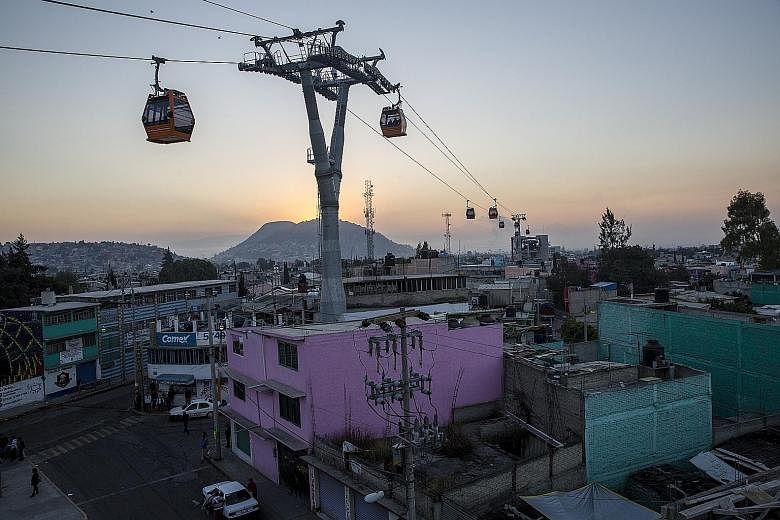ECATEPEC DE MORELOS (Mexico) • Coasting above Mexico City's infernal congestion is normally a prerogative of the well-heeled, who take helicopters or pay to use the upper deck of two-tier highways to avoid the chaos below.
In October, however, thousands of residents in this industrial suburb began getting to work or school in brightly coloured pods that glide along the city's first commuter cable car route.
The Mexicable, a seven-stop line that runs around 5km through poor hillside neighbourhoods, is part of a growing constellation of cable cars around Latin America that links marginalised communities to their cities' metropolitan hearts.
In Ecatepec, the largest and most dangerous municipality in the 21 million-strong expanse of greater Mexico City, the Mexicable has brought new visitors, shorter commutes, a burst of street art and a new sense of inclusion in city life.
"It's great," said Mr Marco Antonio Gonzalez, who used to spend an hour in a cramped bus to get from his home in San Andres de la Canada, the Mexicable's final stop, to his job at a warehouse in the centre of Ecatepec. He now has a smooth, 17-minute cable car ride over rooftops, balding soccer pitches and narrow streets strung with glittery bunting. "People never build something as impressive as this in a neighbourhood like ours," he said.
Ecatepec stretches north from the tip of the capital's subway network into steep hills where square cinder-block houses are stacked like Lego pieces. Many who use the cable car also take a bus and then a subway to reach jobs - at restaurants, homes, offices or construction sites - in more affluent parts.
Ms Nancy Montoya, a housekeeper who lives in Esperanza, near the sixth Mexicable stop, said she saves about two hours a day with the new system - time she now spends with her children or buying groceries.
Her commute is also less frightening. Ms Montoya, 36, has been robbed on buses so often that she has lost count, a complaint heard repeatedly from residents. Nowadays, she looks down on the combis (microbuses) from her commute.
"I imagine they're still robbing people," she said, "but it doesn't affect me."
Over the past 12 years, gondola systems have been built in cities that include Cali and Medellin in Colombia; Caracas, Venezuela; La Paz, Bolivia; and Rio de Janeiro. There are plans to build systems in half a dozen other Latin American cities, according to the Gondola Project, which tracks cable car programmes worldwide.
NYTIMES

